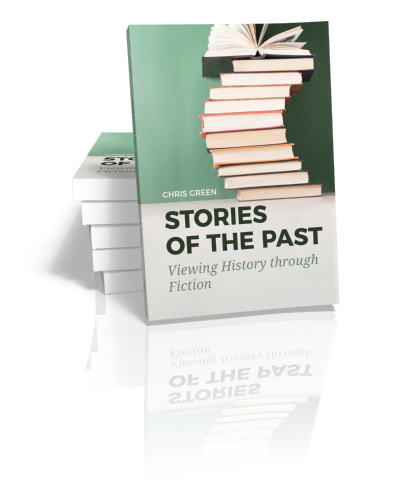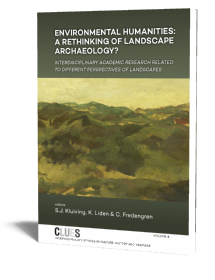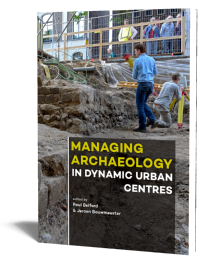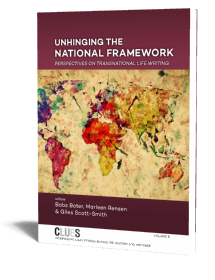Stories of the Past
Viewing History through Fiction
Chris Green | 2022

Stories of the Past
Viewing History through Fiction
Chris Green | 2022
Paperback ISBN: 9789464280333 | Hardback ISBN: 9789464280340 | Imprint: Sidestone Press Dissertations | Format: 182x257mm | 228 pp. | Language: English | 12 illus. (bw) | 40 illus. (fc) | Keywords: history; fiction; classic fiction; perception; reception; fiction process; interpretation; adaptation; criticism | download cover
Read online 92 times
- Digital & Online access
-
Buy via Sidestone (EU & UK)
-
Buy via our Distributors (WORLD)
For non-EU or UK destinations you can buy our books via our international distributors. Although prices may vary this will ensure speedy delivery and reduction in shipping costs or import tax. But you can also order with us directly via the module above.
UK international distributor
USA international distributor
-
Bookinfo
Paperback ISBN: 9789464280333 | Hardback ISBN: 9789464280340 | Imprint: Sidestone Press Dissertations | Format: 182x257mm | 228 pp. | Language: English | 12 illus. (bw) | 40 illus. (fc) | Keywords: history; fiction; classic fiction; perception; reception; fiction process; interpretation; adaptation; criticism | download cover
Read online 92 times

We will plant a tree for each order containing a paperback or hardback book via OneTreePlanted.org.
This study contends that the creation and consumption of fiction has not been looked at in a holistic way in terms of an overall process that takes us from author to consumer with all of the potential intermediate steps. It proposes and describes just such a process model, which begins with the author, who interacts with elements of his or her contemporary world and incorporates them into the imagined world of the novel. It describes how at each stage in the process other actors engage with the novel in various forms, and create artefacts such as critical reviews, filmed adaptations and tourist interpretations that comprise further imagined worlds that can be compared to the author’s original imagined world, and by extension, the original past world.
Using a number of case studies of English novels of the period from 1800 to 1930, the study looks at what evidence of the process in action tells us about the ability of a novel to act as an adjunct to contemporary records in providing insights into that original real world. These studies incorporate analyses of the novels themselves, and of subsequent artefacts such as film and television adaptations, curated literary places and guidebooks, and reviews. The study concludes that fiction in its various forms, and especially in its adapted and interpreted forms, whilst not a pure historical document as such, can provide us with a vivid image of a past world. It contends that the process model could be used as an aid in the teaching of History or English Literature, or as an aid to the general reader, to help remove the layers of imagined worlds that potentially lie between us and a past historical world, thereby reducing the ability of that layering to create a misleading view of history.
1 Introduction
1.1 Stories of the Past
1.2 History and Fiction
1.3 Beyond the Novel
1.4 A Fiction ‘Process’
1.5 Overall Structure
2 The Literary Tourism Process
2.1 Introduction
2.2 Thomas Hardy – Wessex and Dorset
2.3 Jane Austen – Interpretation through Association
2.4 Conclusion: Literary Tourism and the Classic Fiction Process Model
3 The Adaptation Process
3.1 Introduction
3.2 The ‘Classic’ Novel Canon and Film and TV adaptations
3.3 Far from the Madding Crowd – Recreating Wessex
3.4 North and South – Consumer Perceptions of Milton
3.5 Conclusion: Adaptation and the Classic Fiction Process Model
4 The Critical Process
4.1 Introduction
4.2 Thomas Hardy and the London Critics
4.3 Elizabeth Gaskell and William Rathbone Greg
4.4 Conclusion: Criticism and the Classic Fiction Process Model
5 The Writing Process
5.1 Introduction
5.2 Jane Austen and Hampshire
5.3 Elizabeth Gaskell and Manchester
5.4 Conclusion: Writing and the Classic Fiction Process Model
6 J.B. Priestley’s The Good Companions – Discerning History
6.1 Introduction
6.2 J.B. Priestley and The Good Companions
6.3 Mind Mapping the World of The Good Companions
6.3.1 Mind Maps as a technique
6.3.2 Mind Mapping – Analysis and Summary
6.4 Textual Interpretation of the Yorkshire of The Good Companions
6.4.1 Interpretive Footnotes as a technique
6.4.2 Textual interpretation – Analysis and Summary
6.5 Analysing Adaptations of the World of The Good Companions
6.5.1 The Good Companions on Film
6.5.2 Comparing adaptations – Faithfulness to the Novel
6.5.3 Comparing Adaptations – Faithfulness to the Period
6.5.4 Comparing Adaptations – Summary
6.6 Visiting Priestley’s World
6.6.1 Priestley and Bradford
6.6.2 Visiting the Bradford of The Good Companions and Bright Day
6.6.3 Visiting Priestley’s World – Summary
6.7 Conclusion: The Good Companions as a Historical Resource
7 Stories of the Past: Conclusions
Dr Chris Green
Chris Green is currently Honorary Visiting Research Associate in the Department of History and Archaeology at the University of Chester. He obtained his doctorate from the University of Chester in March 2020, studying the uses of novels as resources for the study of History, having obtained his MA from the same institution in 2006. Following his BA in Geography in 1976, he worked for many years in the Information Technology industry. He is about to start work on a history of Manchester’s Hallé Choir, of which he is a member. He lives in Chester.
Abstract:
This study contends that the creation and consumption of fiction has not been looked at in a holistic way in terms of an overall process that takes us from author to consumer with all of the potential intermediate steps. It proposes and describes just such a process model, which begins with the author, who interacts with elements of his or her contemporary world and incorporates them into the imagined world of the novel. It describes how at each stage in the process other actors engage with the novel in various forms, and create artefacts such as critical reviews, filmed adaptations and tourist interpretations that comprise further imagined worlds that can be compared to the author’s original imagined world, and by extension, the original past world.
Using a number of case studies of English novels of the period from 1800 to 1930, the study looks at what evidence of the process in action tells us about the ability of a novel to act as an adjunct to contemporary records in providing insights into that original real world. These studies incorporate analyses of the novels themselves, and of subsequent artefacts such as film and television adaptations, curated literary places and guidebooks, and reviews. The study concludes that fiction in its various forms, and especially in its adapted and interpreted forms, whilst not a pure historical document as such, can provide us with a vivid image of a past world. It contends that the process model could be used as an aid in the teaching of History or English Literature, or as an aid to the general reader, to help remove the layers of imagined worlds that potentially lie between us and a past historical world, thereby reducing the ability of that layering to create a misleading view of history.
Contents
1 Introduction
1.1 Stories of the Past
1.2 History and Fiction
1.3 Beyond the Novel
1.4 A Fiction ‘Process’
1.5 Overall Structure
2 The Literary Tourism Process
2.1 Introduction
2.2 Thomas Hardy – Wessex and Dorset
2.3 Jane Austen – Interpretation through Association
2.4 Conclusion: Literary Tourism and the Classic Fiction Process Model
3 The Adaptation Process
3.1 Introduction
3.2 The ‘Classic’ Novel Canon and Film and TV adaptations
3.3 Far from the Madding Crowd – Recreating Wessex
3.4 North and South – Consumer Perceptions of Milton
3.5 Conclusion: Adaptation and the Classic Fiction Process Model
4 The Critical Process
4.1 Introduction
4.2 Thomas Hardy and the London Critics
4.3 Elizabeth Gaskell and William Rathbone Greg
4.4 Conclusion: Criticism and the Classic Fiction Process Model
5 The Writing Process
5.1 Introduction
5.2 Jane Austen and Hampshire
5.3 Elizabeth Gaskell and Manchester
5.4 Conclusion: Writing and the Classic Fiction Process Model
6 J.B. Priestley’s The Good Companions – Discerning History
6.1 Introduction
6.2 J.B. Priestley and The Good Companions
6.3 Mind Mapping the World of The Good Companions
6.3.1 Mind Maps as a technique
6.3.2 Mind Mapping – Analysis and Summary
6.4 Textual Interpretation of the Yorkshire of The Good Companions
6.4.1 Interpretive Footnotes as a technique
6.4.2 Textual interpretation – Analysis and Summary
6.5 Analysing Adaptations of the World of The Good Companions
6.5.1 The Good Companions on Film
6.5.2 Comparing adaptations – Faithfulness to the Novel
6.5.3 Comparing Adaptations – Faithfulness to the Period
6.5.4 Comparing Adaptations – Summary
6.6 Visiting Priestley’s World
6.6.1 Priestley and Bradford
6.6.2 Visiting the Bradford of The Good Companions and Bright Day
6.6.3 Visiting Priestley’s World – Summary
6.7 Conclusion: The Good Companions as a Historical Resource
7 Stories of the Past: Conclusions
Dr Chris Green
Chris Green is currently Honorary Visiting Research Associate in the Department of History and Archaeology at the University of Chester. He obtained his doctorate from the University of Chester in March 2020, studying the uses of novels as resources for the study of History, having obtained his MA from the same institution in 2006. Following his BA in Geography in 1976, he worked for many years in the Information Technology industry. He is about to start work on a history of Manchester’s Hallé Choir, of which he is a member. He lives in Chester.
- Digital & Online access
-
Buy via Sidestone (EU & UK)
-
Buy via our Distributors (WORLD)
For non-EU or UK destinations you can buy our books via our international distributors. Although prices may vary this will ensure speedy delivery and reduction in shipping costs or import tax. But you can also order with us directly via the module above.
UK international distributor
USA international distributor
- Browse all books by subject
-
Search all books

We will plant a tree for each order containing a paperback or hardback book via OneTreePlanted.org.
You might also like:
© 2026 Sidestone Press KvK nr. 28114891 Privacy policy Sidestone Newsletter Terms and Conditions (Dutch)








